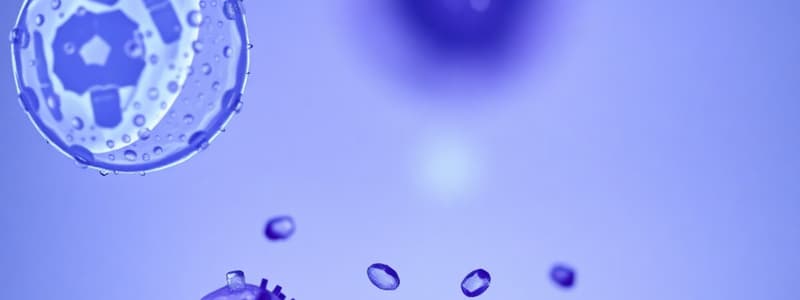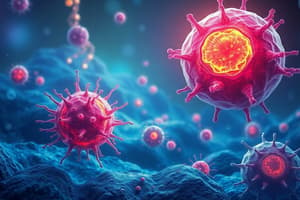Podcast
Questions and Answers
What primarily distinguishes eukaryotic cells from prokaryotic cells?
What primarily distinguishes eukaryotic cells from prokaryotic cells?
- Eukaryotic cells are unicellular organisms.
- Eukaryotic cells lack a nucleus.
- Eukaryotic cells are always larger than prokaryotic cells.
- Eukaryotic cells contain a nucleus within a membrane. (correct)
Which component is unique to plant cells compared to animal cells?
Which component is unique to plant cells compared to animal cells?
- Cytoplasm
- Nucleus
- Cell membrane
- Cell wall (correct)
Which of the following best describes the role of the vacuole in plant cells?
Which of the following best describes the role of the vacuole in plant cells?
- It is responsible for protein synthesis.
- It stores chlorophyll.
- It serves as a storage for cell sap. (correct)
- It performs cellular respiration.
Which type of microscope is most suitable for observing three-dimensional structures?
Which type of microscope is most suitable for observing three-dimensional structures?
What does DNA primarily consist of?
What does DNA primarily consist of?
Which of the following statements about cytoplasm is accurate?
Which of the following statements about cytoplasm is accurate?
What primarily functions as a boundary between the cell contents and its surroundings?
What primarily functions as a boundary between the cell contents and its surroundings?
What is the function of chloroplasts in plant cells?
What is the function of chloroplasts in plant cells?
Which of the following is a characteristic feature of prokaryotic cells?
Which of the following is a characteristic feature of prokaryotic cells?
How do tissues form organs in multicellular organisms?
How do tissues form organs in multicellular organisms?
Flashcards are hidden until you start studying
Study Notes
Cell Structure and Types
- Cells are the smallest unit of life, essential for all living organisms and body tissues.
- Eukaryotes have membrane-bound nuclei within their cells.
- Prokaryotes contain a single, circular DNA molecule.
DNA
- DNA, or Deoxyribonucleic Acid, is the genetic material in cells.
Organism Examples
- Amoeba represents one of the simplest forms of unicellular life.
Cellular Organization
- Similar cells join to form tissues; multiple tissues cooperate to create organs.
Differences Between Animal and Plant Cells
- Animal cells have a cell membrane, cytoplasm, and nucleus.
- Plant cells possess a cell membrane, cell wall, cytoplasm, nucleus, and a vacuole.
Similarities Between Animal and Plant Cells
- Both cell types share a cell membrane, nucleus, and cytoplasm.
Cell Functions
- The cell membrane acts as the boundary separating the cell contents from the environment.
- Cytoplasm is the site for cellular activities and contains organelles like mitochondria and ribosomes, along with food reserves.
- The nucleus houses chromosomes made of DNA, which carry genetic information.
- In plant cells, the cell wall is a non-living outer layer, providing structure.
- Vacuoles in mature plant cells store cell sap, comprising salts and sugars.
- Chloroplasts contain chlorophyll and are responsible for photosynthesis in plant cells.
Types of Microscopes
- Stereo microscope
- Compound microscope: commonly used for viewing small specimens.
- Polarizing microscopes: detect unique optical patterns and phase defects in liquid crystals.
Studying That Suits You
Use AI to generate personalized quizzes and flashcards to suit your learning preferences.




